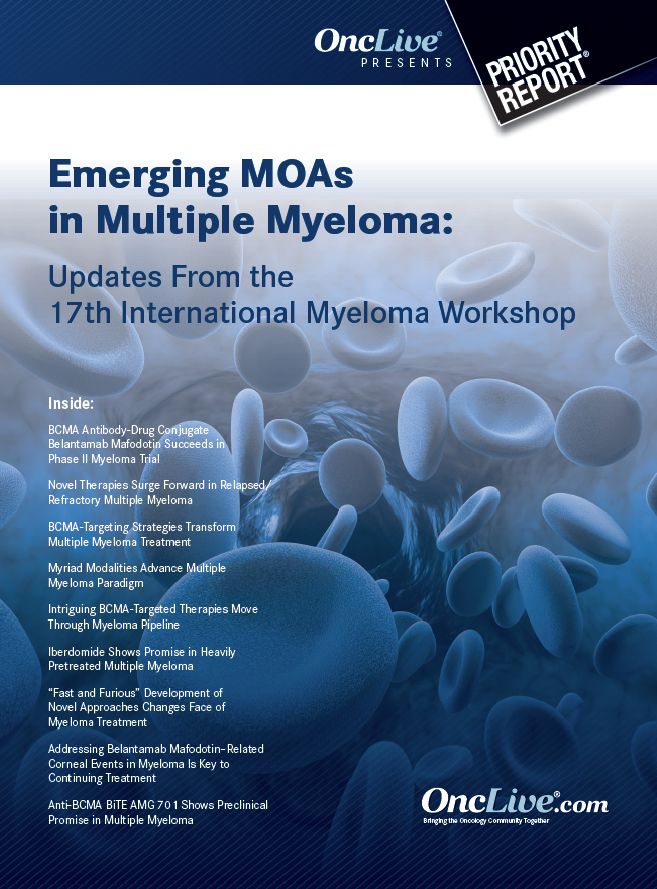"Fast and Furious" Development of Novel Approaches Changes Face of Myeloma Treatment
In an era of personalized medicine in oncology, monoclonal antibodies, bispecific T-cell engagers, and CAR T-cell therapies are revolutionizing patient outcomes in multiple myeloma.
Edward A. Stadtmauer, MD, section chief of hematologic malignancies and professor of medicine at the University of Pennsylvania Abramson Cancer Center

Edward A. Stadtmauer, MD
In an era of personalized medicine in oncology, monoclonal antibodies, bispecific T-cell engagers (BiTEs), and chimeric antigen receptor (CAR) T-cell therapies are revolutionizing patient outcomes in multiple myeloma, said Edward A. Stadtmauer, MD.
For example, CAR T-cell therapies targeting BCMA have shown promising clinical activity and high response rates, noted Stadtmauer.
“The fast and furious development of treatments for myeloma has been amazing,” said Stadtmauer, section chief of hematologic malignancies and professor of medicine at the University of Pennsylvania Abramson Cancer Center in Philadelphia. “BCMA-directed CAR T cells have [led] the majority of patients to respond, and perhaps half of the patients remain in complete remission 1 year later. The hope is that as we move these therapies earlier into the treatment of patients with myeloma, we might see more long-term remissions.”
In an interview with OncLive®, Stadtmauer discussed these personalized approaches and how they are transforming the multiple myeloma paradigm.
OncLive®: With the introduction of immunotherapy, what benefits have been seen with this approach in multiple myeloma?
Stadtmauer: The treatment modalities for all blood cancers are just changing so quickly. We’re so fortunate that we have numerous novel therapies for patients with leukemia, lymphoma, and myeloma.
I have had a 30-year career. When we started treating patients with myeloma, we had oral agents and standard chemotherapies. We were happy if half of the patients responded to therapy, and if they did, they lived with their disease for 2 to 3 years.
With the advent of high-dose melphalan, autologous stem cell transplantation, and now novel agents, immunomodulatory agents, cell modifiers, proteasome inhibitors, and monoclonal antibodies, we are seeing the vast majority of patients respond to therapy and live for decades.
Could you expand on how these novel approaches have affected patient outcomes in multiple myeloma?
We have used daratumumab (Darzalex) and elotuzumab (Empliciti) for a long time, and they have done a great job. Now we are conjugating toxins or chemotherapy to those antibodies and giving directed chemotherapy to patients with myeloma. We have BCMA-directed immunotoxins and BiTEs, which look very promising.
In addition, [CAR T-cell therapy is showing success], although this approach was first designed in acute lymphoblastic leukemia in children and in non-Hodgkin lymphoma in adults. With CAR T-cell therapy, we engineer a patient’s T cells and infuse them back [into the patient].
There are real toxicities with both the BiTEs and CAR T cells, including cytokine release syndrome and neurotoxicities, but these toxicities are generally manageable, with short-term duration.
What allows BCMA to be a unique target in multiple myeloma?
BCMA is a good target, similar to how CD19 is such a good target in lymphoma. More of the immature lymphoid cells are CD19-positive, but most other cells in our body are not. Therefore, [we don’t see] a lot of on-target, off-tumor toxicity.
Also, BCMA appears in the more mature lymphoid cells, such as plasma cells, and are not often seen in many other tissues, so it is a nice target for myeloma. Fortunately, we have seen many responses in that circumstance.
Beyond BCMA, what are some other targets of interest in this space?
Other than BCMA, CD38 has been a great target for myeloma. Daratumumab and isatuximab, another CD38-directed monoclonal antibody, showed great responses and are well combined. Because of that success, CAR T cells and bispecific antibodies are now being developed against CD38.
Also, CS1, or SLAMF7, [has shown promise]. Again, we have a naked antibody that has been successful, and CAR T cells are being generated against those.
Another target that we have used with mixed results has been NY-ESO-1, an antigen that is overexpressed on myeloma and other solid tumors cells.
The FDA recently approved selinexor (Xpovio), an agent with a different mechanism of action. What are your thoughts on that approval and how it will affect treatment going forward?
Right now, we’re using selinexor for patients who have particularly advanced [disease] and have been heavily pretreated. Even in that setting, it is remarkably active, with about 20% of patients responding. As we move the drug earlier in treatment and combine it with other therapies, it will become much [more effective].
There is no question that it has activity; the agent has a logical novel mechanism of action, but it does have toxicities, primarily of gastrointestinal nature. Skill and experience are required in order to help patients through the initial [doses].
Its role may be better defined not as a single agent high doses but perhaps as a lower-dosed agent when combined with other therapies.
What implications could these novel therapies have on hematologic malignancies beyond multiple myeloma?
In some ways, myeloma was the leader in developing these novel agents and mechanisms of actions, but [that changed] very quickly. Acute myeloid leukemia (AML) has entered the fray, with fi ve new agents introduced over the past couple of years.
We now think differently about the initial therapy of AML based on molecular markers: FLT3 mutations, patient age, and underlying myelodysplasia. We’re seeing tremendous improvements with targeted therapies in AML.
Similarly, diffuse large B-cell lymphoma treatment used to be a one-size-fi ts-all approach, which included R-CHOP (rituximab/cyclophosphamide/doxorubicin/vincristine/ prednisone) chemotherapy for all patients. Now, based on pathologic characteristics of B cells, we have additional agents being given via infusion methods rather than bolus methods. We’re seeing tremendous improvements, even in the high-risk, complicated patients.




